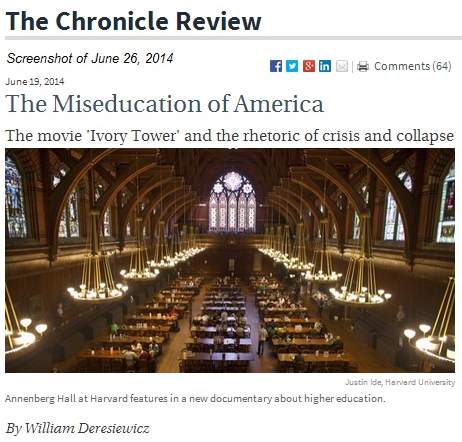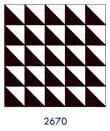Saturday, April 20, 2024
Quilt Geometry: The Crayola Version
Friday, April 25, 2014
Thursday, June 26, 2014
Study This Example, Part II
(Continued from 10:09 AM today)
The quotation below is from a webpage on media magnate
Walter Annenberg.
Annenberg Hall at Harvard, originally constructed to honor
the Civil War dead, was renamed in 1996 for his son Roger,
Harvard Class of ’62.
www.broadcastpioneers.com/
walterannenberg.html —
“It was said that Roger was ‘moody and sullen’
spending large parts of his time reading poetry
and playing classical music piano. It had been
reported that Roger attempted suicide at the
age of eleven by slitting his wrists. He recovered
and was graduated Magna Cum Laude from
Episcopal Academy in our area. For awhile,
Roger attended Harvard, but he was removed
from the school’s rolls after Roger stopped doing
his school work and spent almost all his time
reading poetry in his room. He then was sent to
an exclusive and expensive treatment center
in Bucks County, Pennsylvania. At that facility,
Roger became more remote. It was said that he
often didn’t recognize or acknowledge his father.
On August 7, 1962, Roger Annenberg died from
an overdose of sleeping pills.”
A more appropriate Annenberg memorial, an article
in The Atlantic magazine on June 25, notes that…
“Among those who ended up losing their battles
with mental illness through suicide are
Virginia Woolf, Ernest Hemingway, Vincent van Gogh,
John Berryman, Hart Crane, Mark Rothko, Diane Arbus,
Anne Sexton, and Arshile Gorky.”
Study This Example
The authors of the following offer an introduction to symmetry
in quilt blocks. They assume, perhaps rightly, that their audience
is intellectually impaired:
“A quilt block is made of 16 smaller squares.
Each small square consists of two triangles.”
Study this example of definition.
(It applies quite precisely to the sorts of square patterns
discussed in the 1976 monograph Diamond Theory , but
has little relevance for quilt blocks in general.)
Some background for those who are not intellectually impaired:
Robinson’s book Definition , in this journal and at Amazon.
The McLuhan Dimension
"History is a deep and complicated puzzle—
especially when it involves more dimensions than time."
— Introduction to a novella in Analog Science Fiction
"Annenberg Hall" at Harvard was originally part of a memorial for
Civil War dead. Formerly "Alumni Hall," it was renamed in 1996.
Friday, April 25, 2014
Sunday, March 9, 2014
Sermon
On Theta Characteristics

— From Zentralblatt-math.org. 8 PM ET update: See also a related search.

Some may prefer a more politically correct— and simpler— sermon.
Background for the simpler sermon: Quilt Geometry.
Sunday, July 26, 2009
Sunday July 26, 2009
Happy Birthday,
Inspector Tennison

(See entries of
November 13, 2006)

Related material
for Prospera:
|
Wednesday, September 12, 2007
Wednesday September 12, 2007


Sunday, July 9, 2006
Sunday July 9, 2006
Today’s birthday:
Tom Hanks, star of
“The Da Vinci Code”
and the Holy Grail
Part I:
A Current Exhibit
Part III:
The Leonardo Connection
Part IV:
Nicholson’s Grail Quest
— Ben Nicholson in a 2005 interview
Nicholson’s quest has apparently lasted for some time. Promotional material for a 1996 Nicholson exhibit in Montreal says it “invites visitors of all ages to experience a contemporary architect’s search for order, meaning and logic in a world of art, science and mystery.” The title of that exhibit was “Uncovering Geometry.”
For web pages to which this same title might apply, see Quilt Geometry, Galois Geometry, and Finite Geometry of the Square and Cube.
* “Square Kufi” calligraphy is used in Islamic architectural ornament. I do not know what, if anything, is signified by Nicholson’s 6×12 example of “Kufi blocks” shown above.
Friday, June 16, 2006
Friday June 16, 2006
For Bloomsday 2006:
Hero of His Own Story
"The philosophic college should spare a detective for me."
— Stephen Hero. Epigraph to Chapter 2, "Dedalus and the
Beauty Maze," in Joyce and Aquinas, by William T. Noon, S. J.,
Yale University Press, 1957 (in the Yale paperback edition of
1963, page 18)
"Dorothy Sayers makes a great deal of sense when she points out
in her highly instructive and readable book The Mind of the Maker
that 'to complain that man measures God by his own measure is
a waste of time; man measures everything by his own experience;
he has no other yardstick.'"
— William T. Noon, S. J., Joyce and Aquinas (in the Yale paperback
edition of 1963, page 106)
Related material:
- Dorothy Sayers and Jill Paton Walsh
-
Jill Paton Walsh's detective novel A Piece of Justice (1995):
"The mathematics of tilings and quilting play background
roles in this mystery in which a graduate student attempts
to write a biography of the (fictitious) mathematician
Gideon Summerfield. Summerfield is about to posthumously
receive the prestigious (and, I should point out, also fictitious)
Waymark Prize in mathematics…but it soon becomes clear
that someone with evil intentions does not want the student's
book to be published!By all accounts this is a well written mystery…
the second by the author with college nurse Imogen Quy playing
the role of the detective."— Mathematical Fiction by Alex Kasman,
College of Charleston
- Quilt Geometry, by Steven H. Cullinane
AD PULCHRITUDINEM TRIA REQUIRUNTUR:
INTEGRITAS, CONSONANTIA, CLARITAS.
Monday, August 9, 2004
Saturday, July 20, 2002
Saturday July 20, 2002
|
|
||||
|
Example:
|
||||
|
|
||||
|
|
Initial Xanga entry. Updated Nov. 18, 2006.














